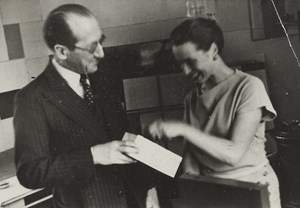
The RKD – Netherlands Institute for Art History purchased eighteen unknown letters and postcards by Piet Mondrian at an auction in Paris. The letters were to the Remonstrant cleric and collector Hendrik van Assendelft, and to an American couple who were fellow artists. The letters to Van Assendelft contain new information on Mondrian's stay in the Netherlands during the First World War, when his work underwent the crucial development from naturalistic to abstract. The letters show that Van Assendelft was an important sounding board for Mondrian.
Image: Piet Mondrian and Gwendolyn Lux (1934)
The RKD – Netherlands Institute for Art History purchased eighteen unknown letters and postcards by Piet Mondrian at an auction in Paris. The letters were to the Remonstrant cleric and collector Hendrik van Assendelft, and to an American couple who were fellow artists. The letters to Van Assendelft contain new information on Mondrian's stay in the Netherlands during the First World War, when his work underwent the crucial development from naturalistic to abstract. The letters show that Van Assendelft was an important sounding board for Mondrian.
Mondrian and Van Assendelft
Mondrian met Van Assendelft in 1914 when a planned visit to the Netherlands turned into a longer than intended stay after the First World War broke out, leaving him unable to return to his studio in Paris. From that moment on, Van Assendelft was of great support to Mondrian by buying some of his work and offering him a place to stay at his home in Gouda. The letters offer a glimpse into their budding friendship and contain until now unknown information on Van Assendelft's role as an editor of the articles Mondrian published after 1917 in the magazine De Stijl. The artist and the priest shared an interest in the spiritual side of art, which Van Assendelft also expressed through his purchases of works by the Russian artist Wassily Kandinsky.

Photos from left to right: Piet Mondrian and Gwendolyn Lux (1934), portrait of Hendrik van Assendelft, letter from Mondrian to Van Assendelft (1914), Source: RKD – Netherlands Institute for Art History
The Mondrian works from the collection previously belonging to Van Assendelft are now housed in the Museum of Modern Art and the Guggenheim Museum in New York.
Mondrian and the Lux Couple
At the same auction, the RKD also purchased letters by Mondrian to the American husband and wife artists Eugene and Gwendolyn Lux. Eugene was a graphic designer and Gwendolyn a sculptor and they were part of the American-European network of avant-garde artists in the years leading up to the Second World War. Eugene Lux played a role in the introduction and acceptance of Mondrian's work in the United States. This helped facilitate his emigration to New York in 1940, keeping him out of reach of the Nazis.

ArtDependence Magazine is an international magazine covering all spheres of contemporary art, as well as modern and classical art.
ArtDependence features the latest art news, highlighting interviews with today’s most influential artists, galleries, curators, collectors, fair directors and individuals at the axis of the arts.
The magazine also covers series of articles and reviews on critical art events, new publications and other foremost happenings in the art world.
If you would like to submit events or editorial content to ArtDependence Magazine, please feel free to reach the magazine via the contact page.